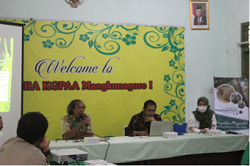Upaya Optimalisasi Lahan Bawah Tegakan pada Zona Tradisional melalui Sosialisasi Budidaya Nilam kepada Pengaram di Taman Hutan Raya K.G.P.A.A. Mangkunagoro I Optimalization of Forest Floor in Traditional Zone through Socialization of Patchouli Cultivation to Forest Farmers in K.G.P.A.A. Mangkunagoro I Forest Park
Main Article Content
Abstract
The socialization of patchouli cultivation was conducted at Forest Park (Tahura) K.G.P.A.A. Mangkunagoro I, located at Mount Lawu, in Berjo Village, Ngargoyoso District Karanganyar Regency. Tahura K.G.P.A.A. Mangkunagoro I was divided into several zones. The most critical zone for the local community is the traditional zone. So far, the traditional zone was used by the community/forest farmers (pengaram) to plant grass (Pennisetum purpureum) under the main stand. The grass was planted mainly for animal feed or sale. During the dry season, the main problem was that the grass did not grow well. Thus, forest farmers do not have additional income from the traditional zone. For this reason, it was necessary to enrich understorey species that mainly have high economic and ecological values. One of the potential plants to be developed understands at traditional zone was patchouli (Pogostemon cablin Benth.). Patchouli is an essential oil-producing plant. It is easy to cultivate and has high economic value. The purpose of this community service was to provide knowledge to forest farmers about patchouli plants. The activities carried out in this program were providing counseling to forest farmers about the theory related to patchouli cultivation and its benefits, business opportunities, oil processing, and mentioned costs and income from patchouli cultivation. The result shows that the knowledge about patchouli cultivation was new for the forest farmers. Forest farmers and Tahura K.G.P.A.A. Mangkunagoro I staff showed interest in cultivating patchouli under forest stands in traditional zones.
Downloads
Article Details
Authors who publish with this journal agree to the following terms:
- Any article on the copyright is retained by the author(s).
- Author grant the journal, right of first publication with the work simultaneously licensed under a Creative Commons Attribution License that allows others to share work with acknowledgment of the work authors and initial publications in this journal.
- Authors are able to enter into a separate, additional contractual arrangements for non-exclusive distribution of published articles of work (eg, post-institutional repository) or publish it in a book, with acknowledgment of its initial publication in this journal.
- Authors are permitted and encouraged to post their work online (e.g., in institutional repositories or on their websites) prior to and during the submission process, as can lead to productive exchanges, as well as earlier and greater citation of published work.
- The article and any associated published material is distributed under the Creative Commons Attribution-ShareAlike 4.0 International License
References
Direktorat Jenderal Perkebunan Kementerian Pertanian Republik Indonesia. 2018. Roadmap Nilam Tahun 2018-2024. Jakarta: Kementerian Pertanian Republik Indonesia
Harli. 2016. Identifikasi dan Potensi Perluasan Tanaman Nilam (Pogostemon cablin Benth.) di Bawah Tegakan Kakao di Kabupaten Polewali Mandar. Agrovital : Jurnal Ilmu Pertanian. 1(1):21-26. http://dx.doi.org/10.35329/agrovital.v1i1.80
Kementerian Perdagangan Republik Indonesia. 2014. Market Brief Minyak Atsiri. Jerman: Atase Perdagangan KBRI Berlin.
Ma’mun, M., Maryadhi, A. 2008. Isolasi patchouli alkohol dari minyak nilam untuk bahan referensi pengujian dalam analisis mutu. Buletin Penelitian Tanaman Rempah dan Obat. 19(1):95-99. http://dx.doi.org/10.21082/bullittro.v19n1.2008.%25p
Nuryani Y. 2006. Budidaya Tanaman Nilam (Pogostemon cablin Benth.). Jakarta: Balai Penelitian Tanaman Rempah dan Aromatik Pusat Penelitian dan Pengembangan Perkebunan Badan Penelitian dan Pengembangan Pertanian
Raharjo, S. Tien, La Ode, A.K. 2020. Pemanfaatan Lahan Tidur melalui Penanaman Nilam di Desa Kosambi Kecamatan Benua Kabupaten Konawe Selatan, Provinsi Sulawesi Tenggara. Jurnal Gema Ngabdi. 2(1):79-82. https://doi.org/10.29303/jgn.v2i1.79
Sahwalita, Herdiana N. 2016. Panduan Pelatihan Budidaya Nilam (I Benth.) dan Produksi Minyak Atsiri. Palembang: Biodiversity and Climate Change Project (BIOCLIME)
Sapareng, S., Akmal, Halid, I. 2017. Sistem Budidaya Loring (alley cropping) pada Pertanaman Kakao dengan Tanaman Nilam di Kecamatan Malangke, Kabupaten Luwu Utara. Jurnal Balireso : Jurnal Pengabdian pada Masyarakat. 2(1):28-36. https://doi.org/10.33096/balireso.v2i1.17
Sari, P.N., Hartono, S. 2010. Dinamika ekspor minyak nilam Indonesia ke Amerika Serikat. Agro Ekonomi. 17(1):19-28. https://doi.org/10.22146/agroekonomi.17860
Sawalia, A., Jamil, M., Anzitha, S. 2018. Analisis Pendapatan Usahatani Nilam (Pogostemon Cablin, Benth) dan Kontribusi Terhadap Pendapatan Keluarga Petani Di Kecamatan Sekerak Kabupaten Aceh Tamiang. Jurnal Penelitian Agrisamudra. 5(1):1-9. https://doi.org/10.33059/jpas.v5i1.817
Tahir, M., Suprapto, Riniarti, D., Ersan. 2018. Pengelolaan Budidaya Nilam (Pogestemon cablin Benth) dan Penyulingan Atsiri pada Kelompok Tani Desa Banjaran di Hutan Lindung Register 20 Pesawaran Lampung. Dharma Raflesia : Jurnal Ilmiah Pengembangan dan Penerapan IPTEKS. 16(2):143-150. https://doi.org/10.33369/dr.v16i2.6451
Widjaja, E.A., Rahayuningsih, Y., Rahajoe, J.S., Ubaidillah, R., Maryanto, I., Walujo, E.B., et al. 2014. Kekinian Keanekaragaman Hayati Indonesia. Jakarta: LIPI Press
